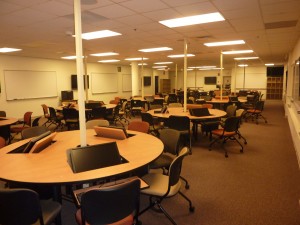It was a case of lab envy that inspired professor Marie desJardins to dream up ACTIVE, the new dynamic laptop lab that will sprout up in the Engineering/Computer Science building next fall.
The culprit? CASTLE, the Active Science Teaching and Learning Environment created by the College of Natural and Mathematical Sciences in 2010 (pictured below). While teaching in the space for one of her courses, she looked at the low-profile computer screens, wall-mounted monitors, and circular workstations and thought: “Why don’t we have one of these?”
 When the Hrabowki Fund for Innovation was announced, Dr. desJardins and a team of CSEE professors including Penny Rheingans, Tim Finin, and Charles LaBerge submitted a proposal to make a similar lab space a reality. This February, the team was awarded a Hrabowski Innovation Implementation and Research Grant to create ACTIVE (Active Computing Teaching and InnoVation Environment), a new classroom that will make group work and active learning a priority.
When the Hrabowki Fund for Innovation was announced, Dr. desJardins and a team of CSEE professors including Penny Rheingans, Tim Finin, and Charles LaBerge submitted a proposal to make a similar lab space a reality. This February, the team was awarded a Hrabowski Innovation Implementation and Research Grant to create ACTIVE (Active Computing Teaching and InnoVation Environment), a new classroom that will make group work and active learning a priority.
This semester, the future site will be transformed from an abandoned classroom to a “dynamic laptop laboratory”. desJardins and co. envision a room with movable furniture and easily-accessible floor power outlets. The idea is to create an open space that will make it easy for students to collaborate and for teachers to interact with students. This physical re-design is being supported by a grant from BAE Systems and the Northrop Grumman Foundation.
Instead of filling the space with bulky, expensive desktop computers that will be outdated in a few years, the lab will network students’ personal laptops using special software. It will allow for screen and application sharing between computers, an instant messaging tool between teachers and students, the ability to edit and create documents collaboratively, and more. desJardins explains it as a virtual infrastructure laid over the physical space.
“The key innovation is that courses that have traditionally been taught in a primarily lecture-based format will be able to take advantage of the physical space and software support to incorporate group activities, collaborative online problem solving and programming, real-time quizzes, and interactive laboratories that are interspersed with mini-lectures,” says Dr. desJardins. These teaching techniques will ultimately help students learn better.
A section of Dr. desJardins’ CMSC 101: Introduction to Computing is one of four pilot courses that will be taught in ACTIVE come fall 2013. Others include Dr. Rheingans’ CMSC 346: Data Visualization, Dr. Finin’s CMSC 331: Programming Languages, and Dr. LaBerge’s CMPE 450: Computer Engineering Capstone.
Some classes have been begging for such a set up. CMSC 101 relies on group activities to help students—especially women and underrepresented minorities—feel engaged and incorporated into the Computer Science community. Last year it suffered when taught in a traditional computer lab, where the rows of cumbersome computers made it impossible for students to see the board or to break into teams. ACTIVE will make Dr. LaBerge’s Computer Engineering Capstone even more true to working in the industry by emulating state-of-the-art industrial research and development companies like Apple and Microsoft.
This summer, all four professors will re-design their classes to best make use of the space.
Dr. Tim Finin says that adapting his Principles of Programming Languages class will “be a challenge,” but, a worthwhile one. Increasing active learning in the class will help transfer students —who typically take it in their first semester—with the often-difficult adjustment. Dr. Finin is considering techniques like “Pair Programming” and having students program in-class.
He sees the new space as a “step in trying to understand how we can teach better by exploiting new technology.” Finin thinks that the relationship between technology and education is bound to grow. “[Technology] could potentially have as big an impact on education as online-shopping had on retail sales, or as the web had on the news industry,” he says.
desJardins predicts that ACTIVE will help professors learn how to teach better, switching the focus from teaching content to teaching skills. Throughout the semester, the team will evaluate the effectiveness of their classes and share their findings at the Provost’s Teaching and Learning Symposium. They hope to share their experiences, and the space, with other professors at UMBC—professors who one day might say to themselves: “Why don’t we have one of these?”